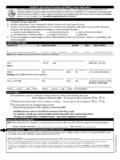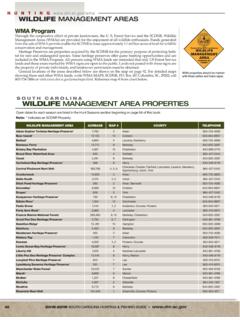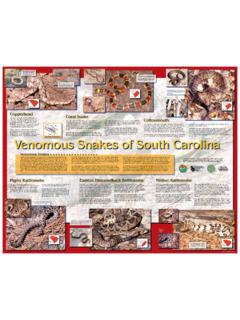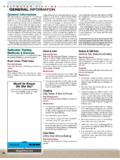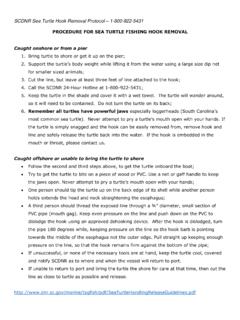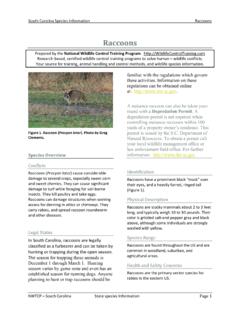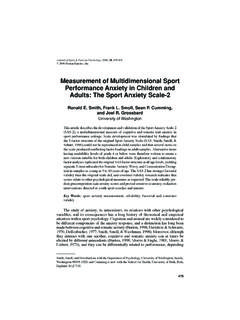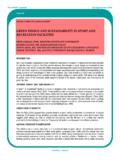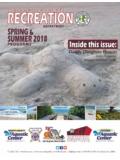Transcription of COYOTE
1 COYOTE (Canis latrans)Biology and Control In south CarolinaSouth carolina department of natural ResourcesDivision of Wildlife and Freshwater FisheriesFurbearer Box 167 Columbia, SC 29202 COYOTE1tracks of coyotetracks of coyotetracks of dogtracks of doghindhindfrontfronthindhind21 COYOTE has the general appearance of a small shepherd-type dog; standing 23 to 26 inches at the shoulder with a slim muzzle, erect pointed ears and a bushy tail. The fur is generally a grizzled, grayish-brown but varies greatly from a light tan or reddish-tan to almost black. The typical COYOTE weighs 30 to 45 lbs, though coyotes over 60 lbs. have been recorded in other states. frontCoyote tracks are similar to other dog tracks; however a COYOTE s tracks are usually longer than they are wide. Their tracks are usually more compact than dogs , and their stride is longer, about 16-18 inches while trotting. Typical COYOTE tracks are 2-3 inches long and 1 1/2 to 2 inches wide with the front heel pad being larger than the rear.
2 Often, only the middle two claws will be present in the tracks. COYOTE scat varies depending on their diet. Often it is cigar shaped and may contain bone, hair, berries and seeds. COYOTE scat may also be nearly formless and dark red to black in color after feeding on larger animals. The most likely places to find COYOTE scat is along dirt roads, on ridges, trails, near large rocks or prominent clumps of vegetation. It is believed that COYOTE scat is often deposited to mark historically found in the western half of the United States, the COYOTE is now found throughout North America due to range expansion and translocation by houndsmen groups. Populations in south carolina were established in Pickens and Oconee counties in the late 1970 s by houndsmen, and coupled with natural immigration, have since expanded to include all counties in the State. Contrary to popular belief, the south carolina department of natural Resources (SCDNR) did not stock coyotes in south carolina to control the white-tailed deer population, or for any other traditionally believed to be adapted to life in open areas, coyotes have expanded into most types of habitats.
3 While they do well in agricultural communities, their relatively high tolerance for human populations allows coyotes to exist in most areas of south carolina . This includes mountainous regions, swamps, dense forests as well as suburban areas. Feeding HabitsFeeding HabitsCoyotes are opportunistic feeders. While rabbits probably comprise the majority of their prey items, they also eat rodents and other small mammals, and supplement their diet with fruits, berries, and insects. They will eat carrion and will also prey, to a limited degree, upon deer fawns and occasionally on adult deer. Deer predation is not significant enough to limit deer populations in south can also prey on domestic poultry and livestock, particularly sheep, goats and calves. Calf predation usually subsides after weaning. Cows giving birth, especially animals having difficult births, can be susceptible to predation as they usually separate from the herd while birthing.
4 On occasion, coyotes will prey on domestic pets. Pet predation is usually due to the territorial nature of the COYOTE and lack of an alternative prey base in suburban are typically most active beginning at twilight and continuing throughout the night. In some areas they may be seen during the day, especially when left undisturbed. Coyotes have a keen sense of smell and good eyesight. They can reach speeds of 40 mph for short durations, though they can sustain relatively high rates of travel over several miles. Resident, or territorial male coyotes, typically have a home range from 2 to 20 square miles, with females occupying smaller ranges. Transient animals usually have much larger home ranges than resident animals, again with the males having larger ones than the females. Coyotes may move several miles within their home range daily, and their movement activity usually peaks during breeding usually hunt alone or in pairs and may travel over fairly large areas in search of food.
5 Basically solitary animals, coyotes do not form packs, but family groups may be seen occasionally. These family groups may consist of a mated pair, non-breeding offspring from the previous year, and the current year s have various calls in addition to howling that include yips and barks. Typically, their vocalizations are used to communicate location or to gather individuals together. COYOTE vocalizations usually peak during the breeding season, and vocalizations are generally more frequent during clear nights with moderate temperatures. Often, loud noises from trains, airplanes or sirens will trigger COYOTE are generally monogamous, breeding mostly in February and March. The gestation period is 63 days and the average litter size is 5 to 7. The pups begin to leave the den at 3 to 4 weeks, are weaned at 8 to 9 weeks and the family breaks up permanently at 9 to 10 months. In areas when food is abundant, 2female young of the year may breed the following winter.
6 Both adults, and on occasion other adults linked with the breeding pair, will hunt and bring food to their young. While raising young, coyotes will den in brushpiles, banks, gullies, and old abandoned barns. Sometimes coyotes will den in burrows of other animals after enlarging and digging out their holes. Coyotes generally do not use dens except when rearing young, preferring to bed in tall grass and brush at other times of the are capable of interbreeding with domestic dogs, but survival of the offspring is low. Typically, coy-dogs breeding cycles do not correspond to coyotes thus further breeding with coyotes is unlikely even though coy-dogs are able to FactorsControlling FactorsCoyotes are subject to canine distemper, parvo, hepatitis, mange and rabies. Coyotes also harbor a variety of parasites such as fleas, ticks, worms, and take from hunting activities, most notably deer hunting, comprise most of the yearly COYOTE harvest in south carolina .
7 Although western pelts may bring relatively high values, a strong market has not developed for the eastern COYOTE . Therefore, there is little incentive for sport trappers to target coyotes, keeping the commercial harvest of coyotes low. However, as nuisance COYOTE problems increase, the demand for contract COYOTE control work should increase and the number of coyotes taken from trapping by Nuisance Wildlife Control Operators (NWCOs) will may be hunted throughout the year with a valid hunting license. However, there may be certain weapon restrictions outside of the deer season in some parts of the State. The use of electronic calls is legal statewide, but coyotes cannot be hunted at night. Check the current SCDNR Hunting Rules and Regulations before hunting coyotes in your area. Individuals may trap coyotes during the trapping season (January 1 - March 1) with a valid commercial fur harvest license along with a valid hunting license.
8 Check the current SCDNR Commercial Fur Harvest brochure for more information about trapping permits are available for controlling destructive coyotes year round. No hunting or trapping license is required with a depredation permit. For more information about depredation permits, see the Depredation Permits section in the back of this publication or contact the DNR Furbearer Project at (803) IdentificationDamage IdentificationCoyotes and their associated damage are quickly becoming unpopular with livestock producers and sportsmen. Nevertheless, attempts in other states to eliminate or drastically reduce the COYOTE population on a large scale have proven largely unsuccessful. However, it is possible to control COYOTE -related damage at the local level by removing the offending animals. If coyotes in the area are not causing specific depredation problems, it is suggested they not be removed. Coyotes are territorial, and their removal may be replaced with coyotes that are more likely to cause depredation case of suspected COYOTE depredation, the area should be searched for tracks, droppings, or any other sign that might indicate a COYOTE s presence.
9 However, coyotes will scavenge dead animal carcasses; therefore, the presence of a dead animal with COYOTE sign in the vicinity does not necessarily indicate COYOTE depredation. Accurately determining COYOTE depredation involves carefully examining the carcass. Hemorrhaging just under the skin at the bite marks indicate the animal was alive when bitten; however, tooth marks under the skin without accompanying hemorrhage indicate the animal was fed upon while dead. The surrounding area should also be investigated for signs of a struggle. Attacks on larger animals usually involve a longer duration of attack, and the adjacent area may have broken vegetation, drag marks or scuffs, as well as blood and/or hair at the site of the kill. Typical COYOTE predation involves attacking the throat of the prey, though some attacks on calves may be to the flanks or hindquarters. The presence or absence of this predation pattern, however, does not necessarily indicate COYOTE predation.
10 Domestic dogs, which typically attack the flanks, hindquarters and heads of animals, will exhibit COYOTE predation patterns while some coyotes may resemble that of domestic dogs. Often domestic dogs will not feed on the killed animal, though true feral dogs and coy-dogs may kill for food and be efficient predators. Only a thorough investigation of the kill and surrounding area may help determine the actual predator of predation can be a difficult task. The amount of evidence at the site of the kill along with the amount of prey and the age of the carcass are factors in assessing the source of predation. Usually, accurate determination of predation involves experience and a keen knowledge of the species of predators in the area. Even this acquired skill may not confirm the cause of death in many TechniquesNon-lethal ControlExclusionFencing, where practical, can deter livestock predation. Traditional barbed wire fences are not a deterrent to coyotes.


